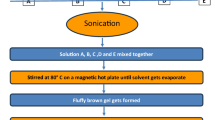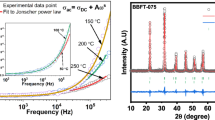Abstract
A multiferroic material with a wide range of uses is bismuth ferrite, which shows outstanding potential. Ca and Ti co-doped BFO samples have been synthesized by the modified sol–gel method. The crystal structures of the samples have been confirmed by x-ray diffraction. The microscopic dielectric relaxations and conduction processes in these materials have been analyzed using complex impedance, complex electric modulus, and frequency-dependent ac conductivity analyses. The modified Debye’s function has been used to study the dispersion behavior of the dielectric constant. The brick-layer model has been used to describe the dielectric characteristics of each sample. Furthermore, to study the conduction mechanism, ac conductivity data have been analyzed using Jonscher’s power law and the Arrhenius equation. The Arrhenius technique was used to calculate the relaxation time as well as the activation energies using the imaginary part of the electrical impedance and the modulus. The presence of non-Debye-type relaxation processes, which include localized and long-range relaxation processes, is supported by the electric modulus spectroscopy.
Graphic Abstract


















Similar content being viewed by others
References
W. Eerenstein, N.D. Mathur, and J.F. Scott, Multiferroic and magnetoelectric materials. Nature 442, 759 (2006).
G. Catalan, and J.F. Scott, Physics and applications of bismuth ferrite. Adv. Mater. 21, 2463 (2009).
D.H. Wang, W.C. Goh, M. Ning, and C.K. Ong, Effect of Ba doping on magnetic, ferroelectric, and magnetoelectric properties in mutiferroic BiFeO3 at room temperature. Appl. Phys. Lett. 88, 212907 (2006).
C. Ederer, and N.A. Spaldin, Weak ferromagnetism and magnetoelectric coupling in bismuth ferrite. Phys. Rev. B 71, 060401 (2005).
R.K. Mishra, D.K. Pradhan, R.N.P. Choudhary, and A. Banerjee, Effect of yttrium on improvement of dielectric properties and magnetic switching behavior in BiFeO3. J. Phys. Condens. Matter 20, 045218 (2008).
I. Sosnowska, T.P. Neumaier, and E. Steichele, Spiral magnetic ordering in bismuth ferrite. J. Phys. C Solid State Phys. 15, 4835 (1982).
J.R. Teague, R. Gerson, and W.J. James, Dielectric hysteresis in single crystal BiFeO3. Solid State Commun. 8, 1073 (1970).
S. Ghosh, S. Dasgupta, A. Sen, and H.S. Maiti, Low-temperature synthesis of nanosized bismuth ferrite by soft chemical route. J. Am. Ceram. Soc. 88, 1349 (2005).
M.M. Kumar, V.R. Palkar, K. Srinivas, and S.V. Suryanarayana, Ferroelectricity in a pure BiFeO3 ceramic. Appl. Phys. Lett. 76, 2764 (2000).
M. Rangi, S. Sanghi, S. Jangra, K. Kaswan, S. Khasa, and A. Agarwal, Crystal structure transformation and improved dielectric and magnetic properties of la-substituted BiFeO3 multiferroics. Ceram. Int. 43, 12095 (2017).
A. Ablat, R. Wu, M. Mamat, J. Li, E. Muhemmed, C. Si, R. Wu, J. Wang, H. Qian, and K. Ibrahim, Structural analysis and magnetic properties of Gd doped BiFeO3 Ceramics. Ceram. Int. 40, 14083 (2014).
S. Chauhan, M. Kumar, S. Chhoker, S.C. Katyal, and M. Singh, Substitution driven structural and magnetic transformation in Ca-Doped BiFeO3 nanoparticles. RSC Adv. 6, 43080 (2016).
R. Das, and K. Mandal, Magnetic, Ferroelectric and magnetoelectric properties of Ba-doped BiFeO3. J. Magn. Magn. Mater. 324, 1913 (2012).
A. Moure, J. Tartaj, and C. Moure, Processing and characterization of Sr doped BiFeO3 multiferroic materials by high energetic milling. J. Alloys Compd. 509, 7042 (2011).
R. Pandey, L.K. Pradhan, P. Kumar, and M. Kar, Effect of Ti Substitution in place of Fe on crystal symmetries and magnetic properties of Bi0.850La0.150FeO3. J. Phys. Chem. Solids 119, 107 (2018).
F. Chang, N. Zhang, F. Yang, S. Wang, and G. Song, Effect of Cr substitution on the structure and electrical properties of BiFeO3 ceramics. J. Phys. Appl. Phys. 40, 7799 (2007).
M. Kumar, and K.L. Yadav, Study of room temperature magnetoelectric coupling in Ti substituted bismuth ferrite system. J. Appl. Phys. 100, 074111 (2006).
Y.-K. Jun, W.T. Moon, C.M. Chang, H.S. Kim, H.S. Ryu, J.W. Kim, K.H. Kim, and S.-H. Hong, Effects of Nb-doping on electric and magnetic properties in multi-ferroic BiFeO3 ceramics. Solid State Commun. 135, 133 (2005).
B. Ruette, S. Zvyagin, A.P. Pyatakov, A. Bush, J.F. Li, V.I. Belotelov, A.K. Zvezdin, and D. Viehland, Magnetic-field-induced phase transition in BiFeO3 observed by high-field electron spin resonance: cycloidal to homogeneous spin order. Phys. Rev. B 69, 064114 (2004).
S. Madolappa, A.V. Anupama, P.W. Jaschin, K.B.R. Varma, and B. Sahoo, Magnetic and ferroelectric characteristics of Gd3+ and Ti4+ co-doped BiFeO3 ceramics. Bull. Mater. Sci. 39, 593 (2016).
J. Rodríguez-Carvajal, Recent advances in magnetic structure determination by neutron powder diffraction. Phys. B Condens. Matter. 192, 55 (1993).
S. Carbonin, F. Martignago, G. Menegazzo, and A. Dal Negro, X-ray single-crystal study of spinels: in situ heating. Phys. Chem. Miner. 29, 503 (2002).
C. Suryanarayana, and M.G. Norton, X-Ray diffraction, 1st ed., (New York: Springer, 1998).
S. Ebrahimi, D. Souri, and A. Khezripour, Strain-size features of bare ZnSe: Cu and ZnSe:Cu@ZnS core/shell quantum dots from extensive x-ray diffraction analysis, and their photoluminescence properties. J. Lumin. 244, 118757 (2022).
A.K. Zak, N.S. Abd Aziz, A.M. Hashim, and F. Kordi, XPS and UV–Vis studies of Ga-doped zinc oxide nanoparticles synthesized by gelatin based sol-gel approach. Ceram. Int. 42, 13605 (2016).
M. Abushad, W. Khan, S. Naseem, S. Husain, M. Nadeem, and A. Ansari, Influence of Mn doping on microstructure, optical, dielectric and magnetic properties of BiFeO3 nanoceramics synthesized via sol–gel method. Ceram. Int. 45, 7437 (2019).
A.K. Jena, S. Satapathy, and J. Mohanty, Magnetic and dielectric response in yttrium (Y)-manganese (Mn) substituted multiferroic Bi1−xYxFe1−yMnyO3 (x = y = 0; x = 0.03, 0.06, 0.12, y = 0.05) ceramics. J. Appl. Phys. 124, 174103 (2018).
S.K. Paswan, L.K. Pradhan, P. Kumar, S. Kumari, M. Kar, and L. Kumar, Electrical transport properties of nanocrystalline and bulk nickel ferrite using complex impedance spectroscopy: a comparative study. Phys. Scr. 97, 095812 (2022).
K.S. Cole, and R.H. Cole, Dispersion and absorption in dielectrics I. Alternating current characteristics. J. Chem. Phys. 9, 341 (1941).
C.H. Rayssi, S. El Kossi, J. Dhahri, and K. Khirouni, Frequency and temperature-dependence of dielectric permittivity and electric modulus studies of the solid solution Ca0.85Er0.1Ti1−xCo4x/3O3 (0 ≤ x ≤ 0.1). RSC Adv. 8, 17139 (2018).
K.L. Ngai, A.K. Jonscher, and C.T. White, On the origin of the universal dielectric response in condensed matter. Nature 277, 185 (1979).
A. Ghosh, Complex Ac conductivity of tellurium cuprate glassy semiconductors. Phys. Rev. B 47, 15537 (1993).
P. Pandit, S. Satapathy, and P.K. Gupta, Effect of La substitution on conductivity and dielectric properties of Bi1−xLaxFeO3 ceramics: an impedance spectroscopy analysis. Phys. B Condens. Matter. 406, 2669 (2011).
A. Laha, and S.B. Krupanidhi, Dielectric response and impedance spectroscopy of 0.7Pb(Mg1/3Nb2/3)O3–0.3PbTiO3 thin films. Mater. Sci. Eng. B 98, 204 (2003).
J. Pcharski, PEO based composite solid electrolyte containing nasicon. Solid State Ion. 28, 979 (1988).
A.R. West, D.C. Sinclair, and N. Hirose, Characterization of electrical materials, especially ferroelectrics, by impedance spectroscopy. J. Electroceramics 1, 65 (1997).
M. Sural, and A. Ghosh, Electrical conductivity and conductivity relaxation in glasses. J. Phys. Condens. Matter. 10, 10577 (1998).
Acknowledgments
The authors acknowledge IIT Patna and Mahatma Gandhi Central University, Bihar for extending experimental facilities.
Author information
Authors and Affiliations
Corresponding author
Ethics declarations
The authors declare that they have no conflict of interest.
Additional information
Publisher's Note
Springer Nature remains neutral with regard to jurisdictional claims in published maps and institutional affiliations.
Supplementary Information
Below is the link to the electronic supplementary material.
Rights and permissions
Springer Nature or its licensor (e.g. a society or other partner) holds exclusive rights to this article under a publishing agreement with the author(s) or other rightsholder(s); author self-archiving of the accepted manuscript version of this article is solely governed by the terms of such publishing agreement and applicable law.
About this article
Cite this article
Shekhar, M., Pradhan, L.K., Kumar, L. et al. Dielectric Relaxation Behavior and Conduction Mechanism of Ca and Ti Co-Doped Multiferroic Bismuth Ferrite. J. Electron. Mater. 52, 6182–6202 (2023). https://doi.org/10.1007/s11664-023-10563-y
Received:
Accepted:
Published:
Issue Date:
DOI: https://doi.org/10.1007/s11664-023-10563-y




